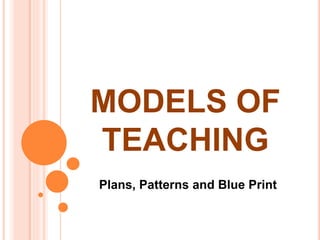
Model of Teaching
- 1. MODELS OF TEACHING Plans, Patterns and Blue Print
- 2. HISTORY Models of teaching emerged out of the search by Bruce Joyce and Marsha Weil(1972) to find a variety of approaches and strategies of teaching to match the various learning styles. They find a solution to the dilemma of different learning styles , with the purpose of all round development of a child. They researched on variety of strategies developed by different learning theories and designed a number of models of teaching.
- 3. MEANING AND CONCEPT Acc to Joyce and Weil • Teaching models are just instructional designs. They describe the process of specifying and producing particular environmental situations which cause the student to interact in such a way that specific change occurs in his behaviour. • Teaching model is a pattern or plan which can be used to shape a curriculum or course, to select instructional materials and to guide a teacher’s actions. • A model of teaching consists of guidelines for designing educational activities and environments. It specifies ways of teaching and learning that are intended to achieve certain kinds of goals.
- 4. CHARACTERISTICS OF MOT Teaching strategies Guidelines Prescriptive Realisation of objectives Instructional material Scientific procedure Specification of environment
- 5. FUNCTIONS OF MOT Three major functions in teaching learning process 1) designing of curriculum or courses of study. 2) development and selection of instructional materials 3) guiding the teachers’ activities in the teaching learning situation
- 6. FAMILY OF MODELS Information processing family • These models help learners to seek and master information, organise it, build and test hypothesis • Concerned with intellectual skills and acquisition of knowledge by students • Egs. Inductive thinking, concept attainment, advance organizer Personal family • Stresses on personal development of individual • More concerned with human feelings and emotions • Egs. Non directive teaching, classroom meeting models Social interaction family • Emphasize the development of capabilities for interpersonal relationships. • Development of social skills • Egs. Group investigation, laboratory methods, role playing Behaviour modification family • Shaping behaviour by manipulating, stimulus, response and reinforcement. • Egs. Self control, stress reduction, direct training model
- 7. ADVANTAGES OF TEACHING MODELS Achievement of specific objectives Effective teaching Teaching and learning relationship Research work Formulation of theories of teaching Psychological teaching Indian models
- 8. FUNDAMENTAL ELEMENTS OF TEACHING MODEL Joyce and Weil designed a procedure for implementation of any instructional model. 1) FOCUS – central aspect of teaching model, objective of teaching 2) SYNTAX- model in action, sequence of steps 3) SOCIAL SYSTEM- relationship between student and teacher 4) PRINCIPLES OF REACTION- reaction of the teacher to students response. By this teacher tune in to the student and select an appropriate response to what the student does. 5) SUPPORT SYSTEM- refers to additional requirements beyond usual capacities and technical facilities necessary to implement model. 6) APPLICATION- learner is able to apply the learnt things in different situations.
- 9. CONCEPT ATTAINMENT MODEL BY J.S. Bruner, J.Goodrow and George Austine(1956)
- 10. INTRODUCTION Model emerged out of the study of thinking process of human beings The model is used to teach concepts to students Assumption is that human being has a capacity to discriminate and to categorize things into groups.
- 11. WHAT IS A CONCEPT? It is a thought/an opinion/a mental image of the thing formed by generalization from particulars, also, an idea of what a thing in general is to be. Deccecco(1968) defines concept as a class of stimuli which have common characteristics. “Concepts are the ideas of abstractions that are formed as a result of categorizing data from a number of observations” Egs. Book, house, plant, adjective, park etc.
- 12. ELEMENTS OF A CONCEPT NAME(of the Concept)- term given eg. Lake, village, fruits, dog. items which form groups together in a single category may differ from another in certain respects. EXAMPLES(Positive & Negative) – positive example demonstrate what the concept is and negative examples what it is not. ATTRIBUTES( Essential and non essential) – characteristic features of a concept. It is any discrete feature of an event that is susceptable some distinct feature is used as means of inferring the identify of something. ATTRIBUTE VALUES- explain the attribute further. Attribute has a range of values. For egs. Colour. Some attributes don’t have range of attribute value. RULE- it is a definition or statement specifying the essential attributes of a concept. For eg triangle is a concept. The rule-a triangle is a closed figure with three sides.
- 13. BASIC ASUMPTIONS OF CAM 1) Capacity of concept formation- discriminate and categorise 2) Reducing complexities 3) Elements of a concept – N,E,A,AV,R 4) Same strategies – all concepts are product of same thought process 5) Reception, selection and unorganised model – *reception- teacher presents egs. (positive and negative), label as ‘yes’ or ‘no’, one by one, form hypothesis and frame rule. * selection – teacher presents egs. ,labelling not done, student select one and inquires whether ‘yes’ or ‘no’, greater responsibility on learner(thinking) * unorganised- group discussion, attain concepts from unarranged material.
- 14. ELEMENTS OF CAM 1) FOCUS- develop inductive reasoning 2) SYNTAX-a) presentation of data- teacher introduces about activity b) analysis of hypothesis * formation of hypothesis * teachers reaction * rejection and confirmation of hypothesis * more examples c) closure- unorganized data d) practice
- 15. 3) Principle of reaction- teacher reacts to responses, for wrong answer aware students, encourage students 4) Social system- control o teacher, reasonable freedom, proper interaction 5) Support system- blackboard, flash cards, flannel board for egs. 6) Application – various disciplines, language and maths
- 16. MERITS OF CAM 1) Development of reasoning 2) Development of imagination 3) Intellectual development 4) Observation 5) Analytical abilities 6) Active participation 7) Self study habit 8) Individual attention 9) No strain 10) application
- 17. DEMERITS OF CAM 1) Absent minded 2) Wrong thinking 3) Non participation
